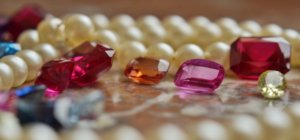 Gemstones are a delight to the eye and it is easy to understand how a collector can easily become infatuated with these gifts from nature. Occurring in every color of the rainbow and many hues in between, gemstone color is a major value factor and a large source of the gemstone’s appeal. Here we will take you for a walk through the spectrum of light and discuss which colors certain gemstones exhibit and why. This list is by no means definitive; rather, it will give you a broad overview of gemstone colors and impart the understanding that there are more mineral varieties with innumerable variations of color than can be listed in a single article. These are gems you are likely to see in the marketplace today, with just a few examples of gemstones that occur in each color range.
Gemstones are a delight to the eye and it is easy to understand how a collector can easily become infatuated with these gifts from nature. Occurring in every color of the rainbow and many hues in between, gemstone color is a major value factor and a large source of the gemstone’s appeal. Here we will take you for a walk through the spectrum of light and discuss which colors certain gemstones exhibit and why. This list is by no means definitive; rather, it will give you a broad overview of gemstone colors and impart the understanding that there are more mineral varieties with innumerable variations of color than can be listed in a single article. These are gems you are likely to see in the marketplace today, with just a few examples of gemstones that occur in each color range.
Violet Gemstones:
- Amethyst: The purple variety of quartz is among the best known of semi-precious gems. Once prized as a precious gem, the discovery of vast deposits of amethyst precluded its assumed rarity, and the gem was downgraded. Saturation can vary from pale lavender to deep
Purple:
- Sugalite: Known for its regal deep purple hue, is found exclusively in the Kalahari desert of Africa. An opaque gemstone, it is usually cut into a cabochon.
- Sapphires: It may surprise you to learn that corundum, the mineral that sapphires and rubies are comprised of comes in almost every hue and purple is no exception. In fact, purple and violet are the most common secondary hues of blue sapphires.
- Tanzanite: Purplish blue tanzanite was originally cut as a more affordable alternative to sapphire. Tanzanite has proved popular for its violet color as well as blue and is a desirable gemstone in its own right, not just as a sapphire alternative.
Indigo:
- Lapis Lazulli: The deep blue hue combined with pyrite inclusions give lapis its appeal. An opaque gem, it is usually cabochon cut and frequently dyed to enhance its deep blue color.
- Sodalite: Similar in appearance to lapis, in that it is opaque but not as deep a blue with steaks of white. Discovered in Greenland, it is cut most frequently as cabochons or beads.
- Kyanite: A beautiful deep blue stone, kyanite can rival the appearance of sapphire. Its beauty is undeniable, but the combination of perfect cleavage planes and an average hardness of 4-7 on the Mohs scale prove problematic for both gem cutters and jewelry setters alike. Kyanite is lovely but fragile.
Blue:
- Sapphire: Most well known and prized among the blue gems, the vivid cornflower blue hue of Sri Lankan sapphires has become the standard of desirability by which most blue sapphires are valued. Frequently referred to as Ceylon sapphires, a name which now is used to describe color more than geographic origin, sapphires from Sri Lanka are typically the best in the world.
- Iolite: A semi-precious gemstone with a medium to dark blue hue but with gray tones or purplish secondary hues. Iolite is frequently marketed as an affordable alternative to sapphire.
- Aquamarine: The pale blue gem of the beryl group, beautiful tone but characteristically weak saturation make fine quality aquamarines expensive for a semi-precious gem due to their rarity.
- Topaz: Occurring in nature in white, yellow, and brown, the electric blue hue of blue topaz in commercial jewelry is achieved through irradiation. Natural blue topaz is far rarer, although new discoveries of mineral deposits in Mozambique containing blue topaz may show potential for mining.
Green:
- Emerald: Colombian emeralds are among the finest in the world, owing this distinction to their vivid green color. Emeralds can range from pale to dark and are often heavily included. Emeralds are often coated with a thin layer of oil to fill in surface reaching inclusions, improving their appearance.
- Tsavorite: Bright vivid green with excellent clarity, East African tsavorite is an affordable semi-precious alternative to emerald.
- Peridot: A pleasing yellowish green semi-precious gem, most of the world’s supply of peridot comes from the state of Arizona.
- Malachite: An opaque semi-precious gems, usually cut into cabochons, malachite is a vibrant green. Gem material exhibits interesting banding patterns and is soft, 3.5-4.0 on the Mohs scale.
Yellow:
- Beryl: Pure beryl is clear, but when iron ions are present it can range from pale yellow to a brilliant golden hue.
- Citrine: The yellow variety of quartz, semi-precious citrine can range from lemony yellow to golden. A product of Brazil, citrine is affordable and attractive.
- Topaz: Imperial topaz is the most rare and valuable of the topaz group. Intense gold color saturation can range from brilliant yellows to orange with pink secondary hues.
- Amber: Comprised of fossilized tree resin, amber is a biogenic gemstone sometimes containing unusual inclusions such as insects or leaves.
Orange:
- Sapphire: The rarest of all sapphires is the padparadscha with its pinkish-orange hue. Its name comes from the ancient Sanskrit description of the color of the lotus flower.
- Fire Opal: Bright to deep orange characterizes this gem from Mexico. Fire opal is usually faceted and can sometimes display the unique color play apparent in black or clear opal but most often does not.
- Carnelian: Revered for its lore in the Muslim world, carnelian has long been associated with power. Its relative softness makes it ideal for carvings. Carnelian jewelry has been discovered in Egyptian tombs, making this one of civilization’s earliest prized gemstones.
Red:
- Ruby: The pigeon blood red of Burmese ruby has made this variety of cornumdum one of the most desired in the world. Trade embargos against Myanmar combined with scarce supply have impacted prices skyward. African rubies from Malawi are gaining popularity in the gem world.
- Spinel: Often confused with ruby, spinel occurs in many colors but its best known hue is red. The famous Timur ruby was later proved to be red spinel.
- Garnet: While found in many colors, the deep red typical of garnet and the exciting vivid dark pink of rhodolite garnet make this an attractive and affordable semi-precious gem.
When assessing color in gemstones, it is important to remember that color is evaluated by three criteria: hue, saturation, and tone. Hue refers to the overall body color of the gemstone; the color that jumps out at you at the first glance. Gemstones will often have a secondary or even tertiary body color as well. Saturation refers to how deep or vivid the color appears, and tone means how light or dark the stone appears. It is important to note that even Diamonds have various colors but color grading on a gemstone has a far greater impact on its value than almost any other factor!
How does color affect your perception of gemstones? Is there a range of color you find more pleasing than others? Post your opinion on gemstone color now and get a colorful conversation started.
Read other posts from the Introduction to Gemstones series.
